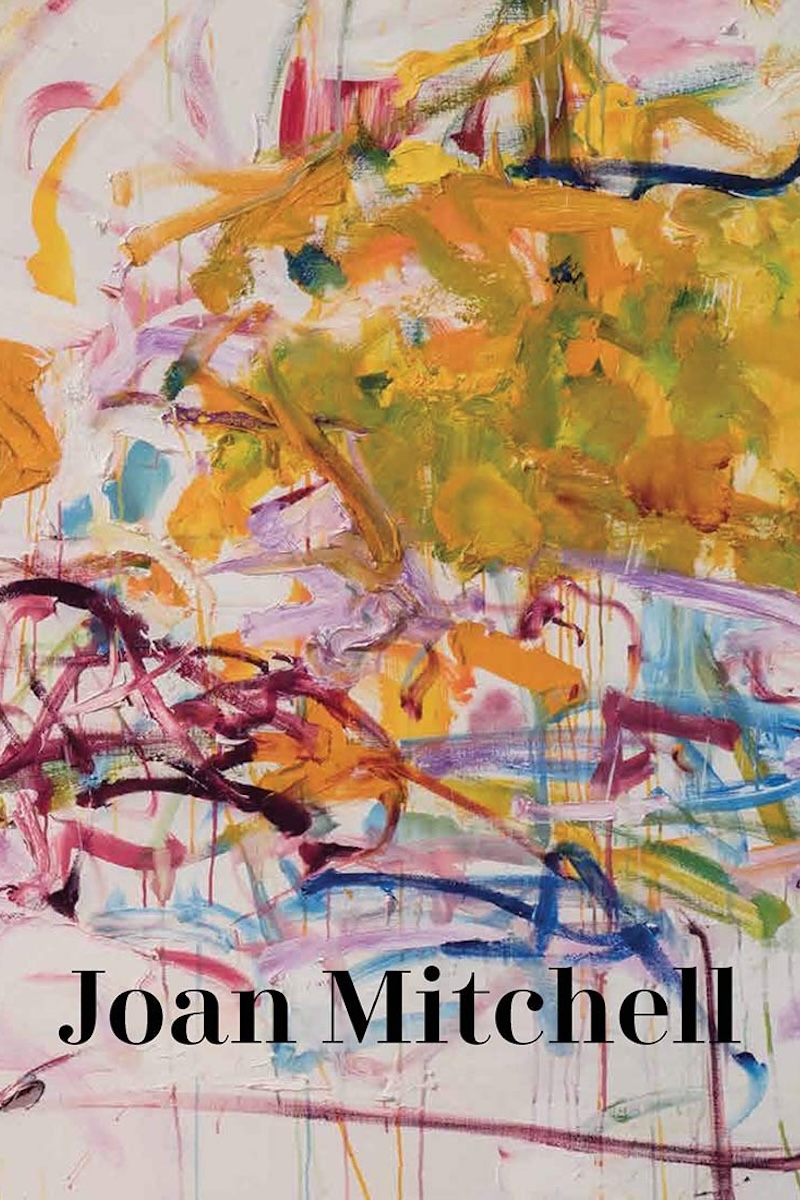‘Joan Mitchell’ Edited by Sarah Roberts and Katy Siegel
The Work of an Artist of Unparalleled Creativity

I’m not sure when I realized that Joan Mitchell was my favorite abstract painter, but I do know it was a gradual process. Partly that time-lag is due to the overwhelming critical attention paid to Mitchell’s male counterparts like de Kooning, Pollock and Rothko. But recognition of Mitchell’s achievement is growing, in part due to books like Mary Gabriel’s Ninth Street Women, but also due to the simple fact that great work will ultimately find its audience.
Looking at the paintings in Joan Mitchell, edited by Sarah Roberts and Katy Siegel and published to accompany an exhibition co-organized by the Baltimore Museum of Art and the San Francisco Museum of Modern Art, I can’t help but lament the years when I wasn’t devoted to her work. Consider just four examples of her genius: the glorious explosions of purple and gold in “Two Pianos”; the undulating squiggles of orange and blue in “Ici”; the big bold blues of the triptych “Bonjour Julie”; and the fiery impact of black on white — or white on black in “Mooring.” If Van Gogh (a hero of Mitchell’s) had been an abstract expressionist, one feels these were directions he might have taken himself.
No doubt about it: Joan Mitchell would be worth buying if it simply contained these gorgeous reproductions of Mitchell’s paintings. However, the book also attempts to explain Mitchell’s overall project as an artist. In addition to the more scholarly essays by Roberts and Siegel, there are a number of short, innovative pieces. Composer Gisèle Barreau discusses Mitchell’s relationship to music (“the tones, shared and secret, magnetic wives, crashing loudly, wave after wave, without beginning or end”); Eileen Myles visits Mitchell’s Greenwich Village (“I admire the newel, the curling metal grip of the balustrade, the handrail leading up to the fancy ass door of the building”); Paul Auster traces the connections between a poem by Jacques Dupin and Mitchell’s painting La ligne due rupture (“La ligne de rupture” is a difficult poem. But Joan didn’t like smooth, easy things. She liked knotty things”).
Poetry looms large in Mitchell’s imagination. Her mother, Marion Strobel, was a poet, and Mitchell often turned to poetry when describing her aesthetic. However, as Jenni Quilter notes in “Love is the Condition of Arriving at Infinity,” “Mitchell’s allegiance to lyric poetry was not to her mother’s writing, but to the promises lyric poetry made as a genre about the self in relation to the world. Lyric poetry was a way to think and access grand ideas, unrepentant in their scale: a love that stretched outward, to encompass nature and the infinite.” That sounds rather grand, but Mitchell’s paintings clearly aspire towards transcendence, and they often have the frenetic energy of some of the best New York School poems — she painted a response to Frank O’Hara’s “Ode to Joy” and “pasteled up” three short poems by James Schuyler. Moreover, she had a poet’s flair for titling her work: “Evenings on 73rd Street,” “No Birds,” “Little Rain,” “Weeds,” and “Bracket,” for example.
“Put your feelings in there,” artist Joyce Pensato remembers Mitchell telling her as a young woman in France in the late 1970s. “Don’t just paint some shit, like you don’t care.” Pensato continues: “Feelings were something very deep, and they gave you something more than just paintings. Her paintings conveyed her own very deep, deep feelings.” Indeed, there is something spiritual about the act of looking at Mitchell’s work. For me, spending time with reproductions of the paintings of the late 60s especially — “Little Trip,” “Sunflower,” “Sans Pierre,” “Blueberry,” “Sans neige” — with their bright yellows and oranges accented by marks or blocks of blue, maroon, and violet, feels like sitting in the nave of a great cathedral, looking up at the stained-glass windows in the apse.
And yet despite the ethereal nature of Mitchell’s best paintings, my favorite prose piece in the book is about technique. In “Joan Mitchell’s Harbor December,” conservator Jennifer Hickey and painter David Reed analyze Mitchell’s painting, brushstroke by brushstroke. Hickey, for instance, identifies an area in the upper-left-hand corner of the canvas that she believes represents an early part of the work: “Here, one can see the early brushstrokes laid in, primarily in greens and plums. Horizontal marks radiate from a central vertical axis, setting up a loose bilateral symmetry that one associates with the body in both scale and structure.” It might sound as though Hickey is reaching, but as the dialogue continues, with Reed commenting that “continual disruption was how marks related to existing ones,” and Hickey responding that the underlying layers of paint “are rarely completely masked. They remain as a record of her decision-making.” One begins to sense the level of thought and craftsmanship that went into paintings that sometimes feel as though they were created in a single burst of inspiration.
The final image in the book is a two-page spread, a color photograph of Mitchell in the late afternoon at her Vétheuil home. Gazing out on the Seine River valley, she looks contemplative, if not exhausted, but she still has one black tennis shoe propped up on the balcony’s railing, as though the day’s work is not yet done. It’s a fitting conclusion for a book that celebrates a woman of relentless, unparalleled creativity.
This review originally appeared in the California Review of Books.










